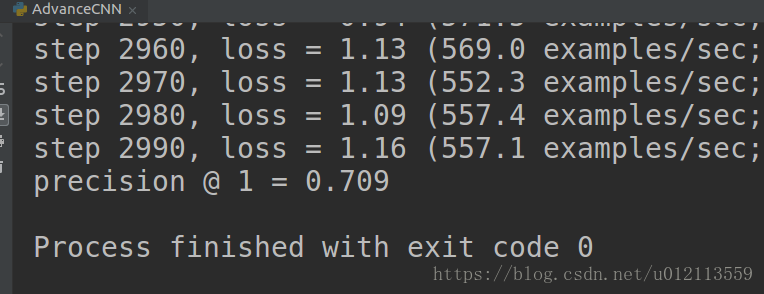今天对照Tensorflow的书,实现了一个进阶的卷积神经网络。基于CIFAR-10数据集。
CIFAR-10数据集官网:http://www.cs.toronto.edu/~kriz/cifar.html
(这里选择二进制版本进行下载)
与之前的简单的神经网络相比,此进阶的神经网络,使用了一些新的技巧:
1. 对weights进行了L2正则化
2. 对图片进行了翻转、剪切等图片增强
3. 使用了LRN层,增强了图片的泛化能力
代码如下:
import cifar10, cifar10_input
import tensorflow as tf
import numpy as np
import time
# 定义一个batch的大小,定义训练轮数maxstep
max_step = 3000
batch_size = 128
data_dir = '/home/heyang/databaseImg/cifar-10-batches-bin'
# 定义初始化weight函数
# 依然使用截断的truncated_normal分布来初始化权重
# 加一个L2的loss防止过拟合
def variable_with_weight_loss(shape, stddev, w1):
var = tf.Variable(tf.truncated_normal(shape, stddev=stddev))
if w1 is not None:
weight_loss = tf.multiply(tf.nn.l2_loss(var), w1, name="weight_loss")
tf.add_to_collection('losses', weight_loss)
return var
# 使用distorted_input产生更多的输入数据,进行数据增强
images_train, labels_train = cifar10_input.distorted_inputs(
data_dir=data_dir, batch_size=batch_size
)
# 生成测试数据,inputs方法里只有裁剪
images_test, labels_test = cifar10_input.inputs(eval_data=True,
data_dir=data_dir,
batch_size=batch_size)
# 创建输入数据的placeholder[batchsize,尺寸,尺寸,通道数]
image_holder = tf.placeholder(tf.float32, [batch_size, 24, 24, 3])
label_holder = tf.placeholder(tf.int32, [batch_size])
# 第一个卷积层
# 其中,池化层为3×3,步长为2×2
# 增加了一个LRN层,归一化局部特征
weight1 = variable_with_weight_loss(shape=[5, 5, 3, 64], stddev=5e-2,
w1=0.0)
kernel1 = tf.nn.conv2d(image_holder, weight1, [1, 1, 1, 1], padding='SAME')
bias1 = tf.Variable(tf.constant(0.0, shape=[64]))
conv1 = tf.nn.relu(tf.nn.bias_add(kernel1, bias1))
pool1 = tf.nn.max_pool(conv1, ksize=[1, 3, 3, 1], strides=[1, 2, 2, 1],
padding='SAME')
norm1 = tf.nn.lrn(pool1, 4, bias=1.0, alpha=0.001 / 9.0, beta=0.75)
# 第二个卷积层
# 次层的LRN层在池化层之前
weight2 = variable_with_weight_loss(shape=[5, 5, 64, 64], stddev=5e-2,
w1=0.0)
kernel2 = tf.nn.conv2d(norm1, weight2, [1, 1, 1, 1], padding='SAME')
bias2 = tf.Variable(tf.constant(0.1, shape=[64]))
conv2 = tf.nn.relu(tf.nn.bias_add(kernel2, bias2))
norm2 = tf.nn.lrn(conv2, 4, bias=1.0, alpha=0.001 / 9.0, beta=0.75)
pool2 = tf.nn.max_pool(norm2, ksize=[1, 3, 3, 1], strides=[1, 2, 2, 1],
padding='SAME')
# 使用全连接层3
# reshape第二个卷积层的输出
# getshape得到数据扁平化后的长度
# 设置了一个非0的weight_loss保证此层都被L2正则约束
reshape = tf.reshape(pool2, [batch_size, -1])
dim = reshape.get_shape()[1].value
weight3 = variable_with_weight_loss(shape=[dim, 384], stddev=0.04, w1=0.004)
bias3 = tf.Variable(tf.constant(0.1, shape=[384]))
local3 = tf.nn.relu(tf.matmul(reshape, weight3) + bias3)
# 全连接层4
weight4 = variable_with_weight_loss(shape=[384, 192], stddev=0.04, w1=0.004)
bias4 = tf.Variable(tf.constant(0.1, shape=[192]))
local4 = tf.nn.relu(tf.matmul(local3, weight4) + bias4)
# 最后一层,正态分布标准差设为上一层层数的倒数
# 不过在此处不使用softmax输出最终结果
weight5 = variable_with_weight_loss(shape=[192, 10], stddev=1 / 192.0, w1=0.0)
bias5 = tf.Variable(tf.constant(0.0, shape=[10]))
logits = tf.add(tf.matmul(local4, weight5), bias5)
# 计算loss
# 把softmax与cross_entropy联合在一起使用
# 然后计算均值
# 然后添加到整体的losses中,得到最终的loss(里面包含两个全连接层的L2)
def loss(logits, labels):
labels = tf.cast(labels, tf.int64)
cross_entropy = tf.nn.sparse_softmax_cross_entropy_with_logits(
logits=logits, labels=labels, name='cross_entropy_per_example'
)
cross_entropy_mean = tf.reduce_mean(cross_entropy,
name='cross_entropy')
tf.add_to_collection('losses', cross_entropy_mean)
return tf.add_n(tf.get_collection('losses'), name='total_loss')
# 设置优化器
loss = loss(logits, label_holder)
train_op = tf.train.AdamOptimizer(1e-3).minimize(loss)
top_k_op = tf.nn.in_top_k(logits, label_holder, 1)
# 创建默认的Session
sess = tf.InteractiveSession()
tf.global_variables_initializer().run()
# 启动线程队列(用于图片数据增强)
tf.train.start_queue_runners()
# 正式训练开始
for step in range(max_step):
start_time = time.time()
image_batch, label_batch = sess.run([images_train, labels_train])
_, loss_value = sess.run([train_op, loss],
feed_dict={image_holder: image_batch, label_holder: label_batch})
duration = time.time() - start_time
if step % 10 == 0:
examples_per_sec = batch_size / duration
sec_per_batch = float(duration)
format_str = ('step %d, loss = %.2f (%.1f examples/sec; %.3f sec/batch)')
print(format_str % (step, loss_value, examples_per_sec, sec_per_batch))
# 评测准确率
# 以top数相同为正确,除以总数为正确率
num_examples = 10000
import math
num_iter = int(math.ceil(num_examples / batch_size))
true_count = 0
total_sample_count = num_iter * batch_size
step = 0
while step < num_iter:
image_batch, label_batch = sess.run([images_test, labels_test])
predictions = sess.run([top_k_op], feed_dict={image_holder: image_batch,
label_holder: label_batch})
true_count += np.sum(predictions)
step += 1
precision = true_count / total_sample_count
print('precision @ 1 = %.3f' % precision)
结果如下:

 进阶CNN实战
进阶CNN实战























 845
845

 被折叠的 条评论
为什么被折叠?
被折叠的 条评论
为什么被折叠?








